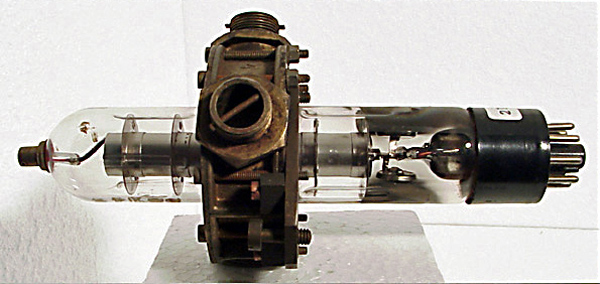|

The CV35 reflex Klystron Oscillator.
The CV35 was invented by Mark Oliphant at the Cavendish Laboratory Cambridge England.
Mark related the following story at the inaugural meeting of the Australian High Vacuum Society, Mark was the Governor of South Australia at that time.
The very rare supply of coconut shell, vital then to pumping very low pressures, was guarded by one of the Lab technicians. Mark and his co-workers desperate to get on with the development went into the lab on Sunday when they knew that the diligent lab tech would be preoccupied at prayer. They carefully lifted the cupboard away from the wall prised off the plywood back and took sufficient coconut to complete their experiments. The back was carefully replaced and the cupboard gently lifted back firmly against the wall.
The lab tech was aware that his supply had diminished, but could not figure out how the thief had by-passed the five locks to achieve the task without leaving a trace.
The CV35 was completed in sufficient time to become the local oscillator in Britains wartime 10 cm Radar. The Naval Type NT 277, The Royal Air Force Type 14 PPI, and the height-finding version the ''Nodding Horror'' to accompany it.
Sir Mark moved on to the Manhattan and Oppenheimer Project contributing significantly towards the first Atomic Bomb.
Additional Information
Our magnificent magnetron would have been worthless without the CV35 to act as local oscillator and the PYE 45 MHz IF strip with the multi-role EF50.
The first application of the semiconductor in the balanced mixers using PIN diodes and a magic TEE. Still only produced a noise figure of 10 dB. So insensitive by today's standards.
The EF50 a valve of many parts. I designed and built a receiver around a single EF50. I reflexed the signal several times through using the various grids as anodes and grids as grids not just electrostatic shields to modify the CAG for the next phase. First the valve acted as an RF amplifier the screen grid acting as anode for a triode circuit, then detector. The audio reflexed once more through the tangle of grids and finally again as the PA to drive a loud speaker which made enough sound to be heard very clearly in all corners of our old (RES), RADAR ENGINEERING Squadron hanger at RAF Henlow. Using the valve in this fashion the AF acted as a pump exploiting the Miller effect. The EF50 was the first real valve; Mullard's did a good job when they invited the EF50 we used it for all sorts of pulse applications including the Phantastron configuration. The other valve that was a champion was the 807 used to control the driving motors to rotate that Type 14 cosec h antenna for the second PPI displays. The first PPI was the H2S of Bernard Lovell's team. The lads were tempted to cross the leads to the top caps of the pair of 807, which put the antenna BTH turning gear into violent oscillation.
The other hero of the day was the Big Thyratron that modulated/switched the PFN (Pulse Forming Network) for the Magnetron anode voltage.
|